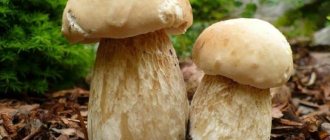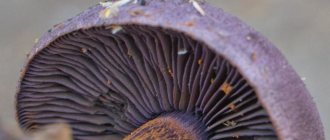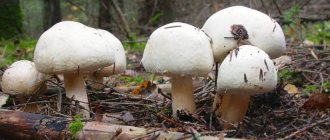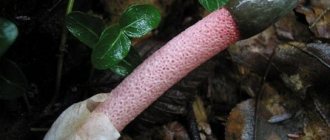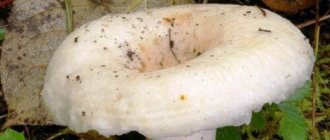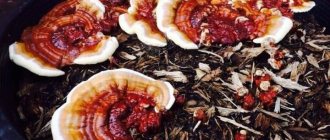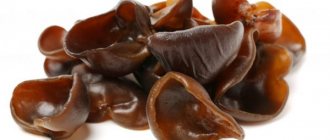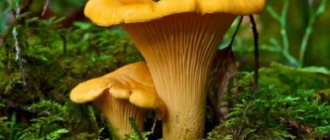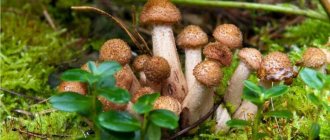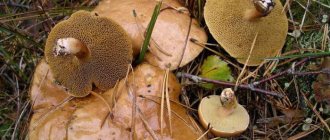You are asking: “Please tell us in detail how and when to collect chaga from birch trees. I want to make a tincture for my joints, plus I still have several orders from friends. At first I wanted to buy it, but then I thought about it and realized that we needed a lot of raw materials, and we have a forest nearby. Why not save money and find it yourself, right? It’s just that they will be collecting for the first time, I don’t know much yet. I saw chaga on alder, can I take this kind or only from birch trees? And now, at the end of autumn, is it not too late to prepare it?”
We answer: Many people consider the tree fungus to be simply a parasite that sucks the juices out of the tree, but in fact, chaga has medicinal properties. Healing tinctures, teas and even ointments are made from the mushroom, which can cure many diseases. In order for the drug to truly be therapeutic, it is important to know how and when to collect chaga from birch trees. Not only the concentration of useful substances depends on this, but also the simplest thing – availability in the “fishery”. Given its unique shape and dark color, the mushroom is not at all easy to see under the canopy of deciduous trees. In addition, it is often confused with tinder fungi. These are the real parasites, who have absolutely no healing power.
What does the birch chaga mushroom look like and where does it grow?
Chaga is listed in the category of tinder fungi. This order includes species of fungi that reproduce by spores that enter the bark of trees. The spores find places in the cortex with broken integrity, where they take root.
Chaga grows as a dark brown growth. But its color is not uniform. In the central part and closer to the trunk, the color becomes lighter. Yellowish veins form in the lower part of the mushroom. The structure of the tinder fungus is solid.
The average weight of one mushroom reaches from 2 to 5 kilograms, and its diameter ranges from 5-10 centimeters to half a meter. In most cases, it is almost impossible to pick it from a tree with bare hands - the mushroom has a soft surface only at the base. Therefore, for this purpose, special tools are used to cut the mushroom.
Most often, chaga can be found in the lower and middle parts of the trunk next to broken branches and twigs. After the spores enter the bark and take root, they begin to grow, destroying the tree, feeding on its sap. Therefore, this fungus is classified as a parasite.
Externally, chaga resembles cake-shaped fruiting bodies, each of which is about 20 centimeters wide and 3 to 4 centimeters thick. The average growth period for a fungus is 10 years. Chaga gradually kills the tree from which it feeds. After the tree dries out, the fungus dies along with it.
Preparing chaga for drying
The collected raw materials should be prepared as follows:
- pieces of chaga are beaten with a sharp knife, getting rid of the light, loose part that was in contact with the wood;
- using an ax, remove the hard black bark covering the top of the chaga;
- the brown inner part is cut into pieces no larger than 3 - 5 centimeters in diameter.
Watch the video from the “Tactical+” channel about the proper collection, cutting and brewing of birch chaga
Varieties
Chaga is an inedible mushroom. This species is classified according to the type of trees it uses. Chaga grows on trunks:
- birch;
- aspen;
- alders
Chaga on a birch
Chaga on aspen
Chaga on alder
But of the listed varieties, only the chaga mushroom growing on birch has beneficial properties. For this reason, the mushroom received its second name.
According to the shape and appearance, chaga is divided into standard and larch growths. The first type is the most common and is characteristic of the above tree species.
Larch chaga grows on the trunks of cedar and fir. Unlike standard chaga, this variety contains mycelium that penetrates the wood and is responsible for the growth of the fungus. Larch chaga coexists with the tree for several decades. This mushroom can be identified by the following characteristics:
- non-standard appearance, reminiscent of a hoof;
- the presence of a rough and bumpy surface;
- cracked crust.
Larch chaga is not an edible mushroom. But unlike other species that do not grow on birch, this species can also be used for medicinal purposes.
Expert opinion
Many herbalists and traditional medicine doctors recognize the effectiveness of birch chaga. Doctor Natalia Dmitrievna Vergazova notes that chaga remedies increase the body’s resistance to negative external influences, have an antioxidant effect and strengthen the immune system. She also talks about chaga as a natural aid in cleansing the body and removing toxins from it, including those produced by alcohol.
Fungotherapist I.P. Kareva points out the effectiveness of chaga in the treatment of purulent skin lesions leading to inflammation and dermatitis of varying severity.
When and how to collect?
Chaga can be harvested throughout the year. But depending on the season, additional difficulties may arise. Thus, in the summer, picking mushrooms is accompanied by the difficulty of searching under the abundant foliage of trees. In the winter season, the main difficulty is snowy weather. Therefore, spring and autumn are best for collecting chaga.
Also, at different times of the year, mushrooms differ in composition. According to experts, chaga contains the greatest amount of beneficial substances in early spring and late autumn.
To collect this type of mushroom you will need a special tool. The easiest way to achieve this goal is with a thick knife or a small hatchet. The procedure for collecting chaga requires quite a lot of effort and a long time.
Inexperienced people often confuse birch fungus with the pest tinder fungus, which also forms on the trunks of birch trees in the form of a growth. The difference between them is color and appearance. The pest fungus resembles a hoof and is lighter in color than the birch fungus. The color of chaga, on the contrary, is dark – the brown shade is more like black. Unlike chaga, the tinder fungus is easily separated from the tree trunk without additional tools.
The higher the mushroom is located along the trunk from the ground, the more useful it is considered . You cannot collect birch mushrooms from dried trees. It contains a minimal amount of useful substances. It is also not recommended to use chaga grown close to the ground.
To search for chaga, it is recommended to use birch groves. Mushrooms grown close to each other are considered more beneficial.
If the chaga is too old, it will also not be of much use for medicinal purposes. You can determine that a birch mushroom is already old by two signs. First, you need to check the color of the pulp - in old mushrooms it is darker than in young ones. Secondly, you need to find out how durable the mushroom is. Reaching old age, chaga begins to lose strength and collapses under pressure.
Birch mushrooms are collected using the following technology:
- after detecting chaga, it is necessary to cut it parallel to the trunk;
- the largest amount of useful substances is contained in the upper part of the mushroom, so the cut must be made at the junction with the tree;
- Careful movements should be made so as not to damage the tree - after detaching the fungus, the cut site on the birch should be sprinkled with earth (this action promotes healing of the wound).
The further method of preparing the mushroom depends on the purposes for which it will be used.
You can learn more about the features of collecting and preparing chaga mushroom for making medicine by watching this video:
How to make a drying chamber for chaga
If the harvesting of beveled tinder fungus is carried out in large volumes, then it is most practical to build a dryer for chaga at the dacha or in the house. It's quite simple to do this:
- The main thing you need to create a drying chamber is a small room in which there is a stove, fireplace or electric oven.
- The room will need to install a high-quality door that prevents drafts from entering. If there are windows in the chamber, it is necessary to install sealed double-glazed windows that do not allow air to pass through when closed.
- All cracks, cracks and other openings in the walls and corners must be sealed with sealant, and the walls themselves must be covered with insulation, which will help maintain a stable temperature. You can line the room with brick from the inside; it will help retain the heat coming from the fireplace or stove.
At the last stage, you will need to build metal shelves in the room on which the workpieces will be placed.
Harvesting in a drying chamber is very simple - the processed tinder fungus is placed in large volumes in a room, the oven is heated and an even temperature is maintained over the next few days for uniform drying.
To dry chaga raw materials, you can equip a special dryer
If the volume of workpieces is very large, you can also build a spacious dryer on the site, the size of which is more reminiscent of a garage. For it you will need to lay a foundation, then assemble a frame from an aluminum profile and metal sheets, and install thermal and waterproofing. Drying is carried out using a heat gun.
A large dryer helps quickly process large volumes of raw materials. However, its construction is profitable only if there is a business based on the sale of birch tinder fungus in wholesale quantities.
Composition and medicinal properties
Chaga contains elements that together provide a healing effect. The list of biologically active substances contained in birch mushroom consists of:
- flavonoids;
- alkaloids;
- tannins;
- groups of organic acids.
Each of the elements in chaga has an individual therapeutic effect:
- organic acids control and normalize the acid-base balance of the human body;
- flavonoids have anti-inflammatory, antispasmodic, diuretic and choleretic effects;
- phytoncides provide an antimicrobial effect;
- alkaloids have a beneficial effect on the heart muscle;
- tannins strengthen and restore the mucous membrane and skin (used for bleeding and inflammation);
- melanin stimulates metabolic processes and restores the body.
Additionally, chaga contains minerals and trace elements. Of these, the most beneficial for human health are:
- magnesium – effective for diseases of bones, joints, teeth, heart, gastrointestinal tract, nervous tissues;
- potassium – helps treat diseases of the blood, heart, kidneys, and gives an antitoxic effect;
- iron – normalizes hematopoiesis and tissue respiration, liver and spleen function, prevents anemia;
- manganese – strengthens bone tissue, improves the absorption of vitamins, relieves inflammation;
- copper – has a beneficial effect on hemoglobin, skin, hair, cellular respiration, oxygen supply, bone tissue building, and nervous system function.
Also, the composition of chaga is filled with zinc, cobalt, nickel, silver and aluminum. Most of the elements contained in birch mushrooms are beneficial to human health. Therefore, chaga is used not only in medicine, but also in cosmetology.
What are the benefits of chaga?
Herbalists know well how effectively chaga helps with gastritis. In conjunction with other medicinal plants, birch polypore successfully treats gastric disorders and ulcers. According to legend, the great Vladimir Monomakh cured a cancerous tumor on his lip with the help of birch mushroom. Chaga tea quickly saturates, invigorates, and increases performance. Other known actions of this unique mushroom include:
- decrease in pressure - venous and arterial;
- regulation of the cardiovascular system;
- wound healing;
- analgesic effect;
- treatment of dermatological diseases;
- joint healing;
- relieving inflammation;
- stimulation of metabolic processes in cerebral cortex cells;
- antioxidant capabilities;
- bioregulation of the body's protective reserves;
- elimination of chronic fatigue syndrome.
Chaga is very useful for diabetes. Lectins contained in birch lip lower blood sugar.
Rich composition
The chemical structure of wood fungus contains microcomponents that are significant for human health. Polyphenolic acids are good biogenic stimulants that restore the body's metabolic processes destroyed by disease.
Melanins, abundantly present in tinder fungus, have a pronounced antioxidant effect and are able to protect the liver from harmful effects. Amino acids (glycine, aspartic and glutamic acids) have a nootropic effect.
Scientists claim that lectins and agglutinins can block the development and spread of tumor cells, which is why chaga mushroom is often recommended in folk medicine for oncology.
For what diseases and how is chaga taken?
Chaga is used for:
- reduced immunity and poor metabolism;
- inflammation affecting the tissues of the oral cavity and gums;
- spasms;
- low quality of work of the central nervous system;
- the need to slow down the development and growth of the tumor;
- stomach diseases (gastritis and ulcers);
- the presence of foci of inflammation;
- insomnia;
- poor cell regeneration;
- depression or nervous tension;
- accumulation of heavy metals in the body;
- high blood pressure;
- poor functioning of liver enzymes;
- treatment of skin diseases (eczema, acne, psoriasis);
- to reduce pain in arthritis, arthrosis, radiculitis.
Before making chaga-based medicine, the mushroom must be properly prepared. Once it is cut from the tree, it should be cut into small pieces and dried. You can speed up the process by using the oven.
The mushroom must be chopped as quickly as possible after cutting from the tree, since it hardens in a short time. After the chaga pieces are dried, they need to be placed in a glass jar or fabric bag. Birch mushroom does not combine well with other materials.
The period during which chaga retains its beneficial properties is 2 years. When it passes, the mushroom can be thrown away.
Decoction
The most common chaga-based medicine is a decoction. In the presence of diseases that affect the larynx and respiratory system, inhalation with birch mushrooms for 5-7 minutes is recommended.
The decoction is prepared according to the following scheme:
- 100 grams of mushroom are placed in a container and filled with 1 liter of cold water;
- the mixture is infused for 24 hours until the mushroom pieces soften;
- the substance is brought to boiling point, after which it settles again for 24 hours.
The finished decoction is used as tea. To do this, part of the mixture must be diluted with boiling water, and the remaining substance must be placed in the refrigerator. After preparation, the decoction retains its medicinal properties for 4 days, and then begins to deteriorate. It is recommended to use it for no more than two weeks. Drinking chaga tea reduces the risk of developing cancer.
Alcohol tincture
Chaga tincture is used in the treatment of cancer. For preparation, in addition to chopped mushroom, you will need vodka. The production of the medicine is carried out according to the following scheme:
- 100 grams of mushroom are placed in a container and filled with 1 liter of vodka;
- the mixture is placed in a cool place out of direct sunlight;
- the substance is infused for two weeks, and once a week you need to shake it, after which the tincture must be strained.
The medicine is taken 1 tablespoon 3 times a day before meals. The tincture can be diluted with 50 milliliters of warm water. The course of admission is 10 days.
Infusion
The infusion differs from alcohol tincture not only in the absence of alcohol in the composition, but also in the method of preparation:
- the mushroom is washed and grated, after which it is soaked in water for 4 hours;
- chaga is mixed with water in a ratio of 1 to 5;
- the substance is infused in a dark place for 2 days.
The infusion is filtered and taken 30 minutes before meals. For the treatment of chronic gastritis, the course duration is up to 6 months. You can add honey and mint. Treatment of adenoma is carried out by adding a mixture of crushed burdock root to the recipe. If the infusion is needed to treat gums, it should be mixed with chamomile and rinsed in the mouth.
During the preparation process, you can use additives to enhance the medicinal effect. Chaga infusion is combined with rose hips, pine buds, St. John's wort, licorice, and yarrow.
Chaga extract can also be prepared from the infusion. To do this, the finished medicine must be mixed with Befungin. This drug strengthens the body, and together with chaga helps in the treatment of gastritis and stomach ulcers.
Ointment
To prepare the ointment, you will first need to grind the mushroom to a powder state. Only after this can you start making the medicine:
- mushroom powder is mixed with pork fat (it is recommended to use fresh fat);
- the ratio of chaga to fat is 1 to 1;
- the mixture is melted using a water bath and brought to a boil;
- the substance is placed in a jar, closed, and wrapped in a warm towel;
- The ointment is infused for 24 hours, after which it is stored in the refrigerator.
Instead of pork fat, it is allowed to use butters - solid fatty oils of vegetable origin.
Chaga ointment is used to treat cancer of the skin, uterus, breast, rectum, lymph nodes, prostate. The medicine also helps in treating swelling of the legs, normalizing blood circulation, strengthening the walls of veins and blood vessels.
Oil
To prepare chaga oil, you will additionally need olive oil. The medicine is prepared according to the following scheme:
- Chaga infusion is prepared;
- 2.5 tablespoons of olive oil are mixed with 1 teaspoon of chaga infusion;
- the substance is infused in a dark, cool place for 24 hours.
Chaga contains pterins, which mix with olive oil and have an antitumor effect. Therefore, the medicine is used to treat various tumor diseases, as well as skin diseases, prostate adenoma, and sinusitis. Additionally, the ointment eliminates pain in muscles and joints.
Making chaga tea
If you do not have the opportunity or desire to devote a lot of time to preparing the infusion, you can brew chaga simply as tea. This option can be used, for example, in hiking conditions or if you want to drink tea in the forest from freshly collected chaga. In terms of its healing properties, this drink is inferior to the first two.
- Boil water in a saucepan (or kettle). If possible, avoid using aluminum cookware;
- Place pieces of chaga in slightly boiling water at the rate of 200-250 g. for 1 liter of water;
- Let the liquid simmer for 10-15 minutes;
- Cool the resulting drink to an acceptable temperature and, as they say, enjoy your tea.
Contraindications and possible harm
Chaga has virtually no contraindications. This mushroom does not contain substances that pose a serious threat to human health. But in some cases, after taking chaga, you may experience:
- intestinal dysfunction (fungal-based medicines act as a laxative);
- overload and excessive stimulation of the nervous system (with prolonged use of decoctions and tinctures);
- individual allergic reaction (if a person is sick with hay fever and atopic dermatitis).
Medicines containing chaga are not recommended for use if:
- problems with the nervous system;
- pregnancy and lactation;
- use of antibacterial drugs;
- internal administration of glucose;
- chronic colitis and dysentery;
- drinking alcohol and smoking.
When treating with chaga, you should minimize the amount of fried and fatty foods in your diet.
Chaga is a mushroom that has a large number of beneficial substances for human health. But if used incorrectly, the effect of taking it will be minimal. Therefore, before using chaga for treatment, it is necessary to study in detail the instructions for preparing medicines based on it, and consult with specialists.
0
0
Copy link
Chaga better insist
Yes, that’s right, this is the method we use in our family. I know that they write about the method of brewing over low heat and then letting it brew. I won’t say that this is wrong, I haven’t tried it, so I don’t know what the result will be.
Note. I am writing about the drink, not about medicinal preparations
Although the drink also has a medicinal effect, it is still used for drinking, and not for treatment. However, the power of birch chaga lies in prevention.
I liked the method that I learned from my wife. This happened in the third or fourth year of our life together. That year, I persuaded my neighbor to go to the hills to buy blueberries, and in addition to the berries, we also found a birch mushroom, chaga. Which, as I realized later, was real luck.
The fact is that in the 90s, the Chinese were very actively buying chaga, and the local population, due to the lack of work and means of subsistence, was very actively involved in collecting and selling it. By the time of my arrival, this boom had already passed, and the consequences were that in all accessible places of the Sakhalin taiga, there was no more birch chaga.
It seems that my friend and I came to the only place, at least in our area, where, apparently, they simply missed it, and for more than ten years we have been enjoying this wonderful drink.
I insist on boiled cold water. I chop chaga, 300 gr. into pieces up to 5 cm in diameter, and fill it with prepared water in an ordinary stainless steel coffee pot, Soviet-made.
After a day, the drink is ready for consumption. As the infusion is drunk, add boiled cold water until we see that the drink has lost its properties. The characteristic smell and taste disappears, and the color also turns from dark brown to pale.
This means it’s time to throw away the used mushroom and prepare a new infusion using fresh raw materials. That's what we do.
When I first saw my wife pouring cold water on the chaga, I was very surprised and even tried to object, but she knew exactly what she was doing. And the next day, pouring chaga into a glass to drink, I smelled a faint smell of medicine. It smelled like medicine. And the taste of this drink, of course, was very different from what I had drunk to this day.
This is how it happens too. My father, being a hunter, spent most of his life in the taiga, he knew birch chaga and carried it home, but he did not know how to prepare it correctly to get the proper healing drink.
I do not recommend brewing chaga by pouring boiling water over it or bringing it to a boil. Because boiling water destroys most of the beneficial properties of the mushroom. However, you can brew birch chaga; you need to finely chop the mushroom into a bowl, add water and heat it to a temperature of 80-90 degrees, under no circumstances bring it to a boil. 80-90 degrees, this is the appearance of the first bubbles. Afterwards you need to let it brew for 15-30 minutes.
What time of year is best to collect chaga?
The mushroom grows on a tree trunk for many years. But when asked when is the best time to collect chaga, experts answer that in the spring. It is during this period of the year that the maximum concentration of nutrients accumulates in the fruiting body.
If suddenly it was not possible to collect chaga in the spring, you can collect it in the fall, after the leaves fall. At this time, the circulation of sap inside the tree trunk slows down and the fungus also tries to accumulate maximum nutrients.
In winter, it is extremely difficult to wander through forest snowdrifts in search of a medicinal plant. And in summer, chaga is sometimes not visible due to the dense green foliage.
Special conditions, humidity, temperature, light
If the mushroom is stored in paper or linen bags, then it becomes very vulnerable to moisture and sunlight, so the answer to the question of how long to store dry chaga depends on environmental conditions. The optimal storage temperature is from 12 to 15 °C. The humidity level should be around 14% or lower. It is allowed to store raw materials in the refrigerator. Excessive humidity encourages mold, and eventually the chaga will simply rot.
It is difficult to check the air humidity level at home, so you need to make sure that the product is dry to the touch. Humidity, temperature and light affect how long chaga can be stored.
Polypore will retain its unique healing properties only if stored correctly. Where the product was collected plays an important role.
In addition, you need to take into account contraindications to taking birch mushroom. These include:
- individual intolerance;
- chronic colitis;
- antibiotic treatment;
- taking glucose medications.
Taking chaga for medicinal purposes should be carried out under the supervision of a doctor and as an additional remedy along with the main treatment. Knowing how long dry chaga can be stored, you will be able to use the healing product for medicinal purposes throughout the year.
Medical properties of chaga
I always thought that birch mushroom was only good for the stomach, that’s why I used it as described above
But realizing that it would be interesting, if not important, for the reader to learn everything that chaga can do, I decided to scour the Internet and was pleasantly surprised. It turns out our chaga is a very good doctor
No wonder the Chinese were buying until the authorities banned export, as a strategic product subject to phytosanitary quarantine control. In order to export this black-brown raw material abroad, you must have a permit in the form of a license, which can only be obtained from an authorized body.
Let's consider the beneficial properties of birch chaga.
The first thing I would like to immediately note is the ability of the birch mushroom to resist cancer, preventing the occurrence of a cancerous tumor. Scientifically, it goes like this:
In general, the formulation is clear except for one phrase: “Inducing apoptosis.” Let's understand these confusing words. To “induce” means to promote the emergence of something. “Apoptosis” is a process programmed in the body of self-destruction of cells that have become unnecessary.
In simple words, this phrase means that birch chaga helps restore the process of self-destruction of waste cells that are unnecessary for the body. Which is disrupted in cancer.
Thus, birch mushroom maintains the mechanism for destroying unnecessary and harmful cells in working order, and therefore is an excellent prophylactic agent for preventing the occurrence of cancer.
By the way, on Wikipedia I found a mention of chaga birch in A. Solzhenitsyn’s work “Cancer Ward”. In a conversation between two patients, one talks about a doctor who noticed that in one village there had been no diagnosis of cancer for many years.
At the same time, such patients arrived from all the nearby settlements it served. When studying this phenomenon, he came to the conclusion that the reason for the absence of oncology was the residents’ addiction to drinking chaga. It looks like I'll be drinking it more often now.
The second medical quality of the birch chaga mushroom is its positive effect on the digestive system. Birch mushroom is rich in polyphenols, which are powerful antioxidants that prevent oxidative processes caused by free radicals.
How can I explain this more simply? In general, in our body, as in politics, there are elements such as free radicals. From them, whether in politics or in the body, only harm occurs - they cause rotting, that is, oxidation, which birch chaga copes with very successfully.
Due to the powerful effect of irritating factors on the mucous membrane, gastritis can begin in the stomach, which is the oxidation process that effectively stops our favorite birch mushroom. In case of poisoning, a drink from chaga helps stop vomiting (tested from personal experience).
As a result, the pain stops. The development of the ulcer stops. Plus, digestion improves.
Birch chaga mushroom has bactericidal and hemostatic properties, which helps fight infections in various types of skin lesions.
The central nervous system also loves our miracle birch mushroom, which is successfully used to treat various nerve diseases. Helps with insomnia, apathy, panic attacks. Neuralgia and nervous arrhythmia also recede due to the high content of sodium and potassium in chaga.>
Strong astringent properties allow chaga birch to cope with diseases of the oral cavity: Periodontitis, periodontal disease, stomatitis. There is also success in the treatment of throat diseases: laryngitis, tonsillitis, pharyngitis, tracheitis.
Swelling.
Purely female and male diseases.
The benefits of alcohol tincture
In addition to decoctions, vodka infusions are also made from chaga. Such a medicine (taking into account its correct manufacture and proper use) can also help in a wide variety of pathological situations. But most often, chaga tincture is used for:
- increasing immunity;
- improving skin condition;
- stopping foci of infection;
- normalization of cholesterol levels;
- relieving pain of various origins;
- cleansing the body of poisons, toxins and waste;
- normalization of the functioning of the hematopoietic organs;
- calming and restoring a healthy night's rest (fighting insomnia).
Procurement of raw materials
Before learning how to prepare chaga tincture with vodka and choosing the appropriate recipe, you should know how to properly prepare the raw materials for the infusion. Chaga should be used growing on a still living tree; if it is cut from a dead tree, there will be no benefit from the treatment.
You should not cut off growths that are too large, black in color, crumbling or growing near the surface of the soil. The chaga is cut with a sharp hatchet; the middle part of the growth should be used to prepare infusions. After cutting, the mushroom should be immediately prepared by cutting into small pieces (chaga hardens very quickly).
When collecting chaga, it is important not to confuse this mushroom with tinder fungus.
The cut mushroom is finely chopped and dried (it is better to use the oven). The prepared raw materials are stored in any glass container or linen bags (the container does not have to be tightly and hermetically sealed). Chaga can be stored for a long time – up to 2–2.5 years. Then the mushroom begins to very quickly lose all its beneficial qualities.
- the outer surface of the tinder fungus is painted gray with various black circles;
- the tinder fungus has a shape similar to an irregular sphere (the top is rounded and the bottom is straight);
- The tinder fungus has a very rough surface, its outgrowths are deformed and hard, the base of growth, on the contrary, is soft and white in color.
Special conditions
You should know that chaga tincture with vodka is not suitable for treatment for all patients. Despite all its proven and invaluable benefits for humans, this medicine has a wide range of contraindications. They are as follows:
- period of pregnancy and lactation;
- congenital intolerance to the fungus;
- therapy with a course of intravenous glucose injections;
- predisposition to the formation of edema and allergic reactions;
- pathologies of the gastrointestinal tract of a chronic nature (for example, dysentery, colitis);
- treatment carried out using antibiotics (especially drugs from the penicillin group), such medications are chaga antagonists (having the opposite effect).
You should also know that chaga tincture is not intended for long-term course use. Too long treatment often provokes the development of serious allergies and increases nervous excitability. Experienced healers advise adhering to the following recommendations during the entire course of taking chaga tincture:
- Exclude hot spices, spices, smoked meats, canned food and animal fats from the diet for the entire period of treatment.
- Enrich your daily menu with dairy products, fruits and vegetables (in any form). These dishes will help prevent possible problems with the digestive system (in some cases, chaga can cause intestinal obstruction).
- During the entire period of treatment with chaga tincture, alcohol consumption should be avoided. It is also advisable to quit smoking or try to reduce the dose of cigarettes you smoke as much as possible.
Shelf life of birch chaga
Of course, everyone is wondering about the maximum shelf life of the birch Chaga mushroom. There are many opposing opinions on this matter. Everyone has their own tips for storing this medicinal mushroom. But any professional biologist will tell you that the approximate shelf life of any mushroom is 2 years. During this particular period, Chaga is able to retain its unique healing properties.
Chaga is a tree mushroom that is used for medicinal and preventive purposes. The product is rich in microelements, including calcium, silicon oxide, sodium, manganese, aluminum. Also contains formic, oxalic and vanilla acids. You need to remember that the mushroom can mold and deteriorate, so you need to store chaga correctly.
Important! The Leningrad Medical Institute conducted a series of experiments that showed that the product is useful in that it tones and restores the nervous system, normalizes the functions of the stomach and duodenum.
